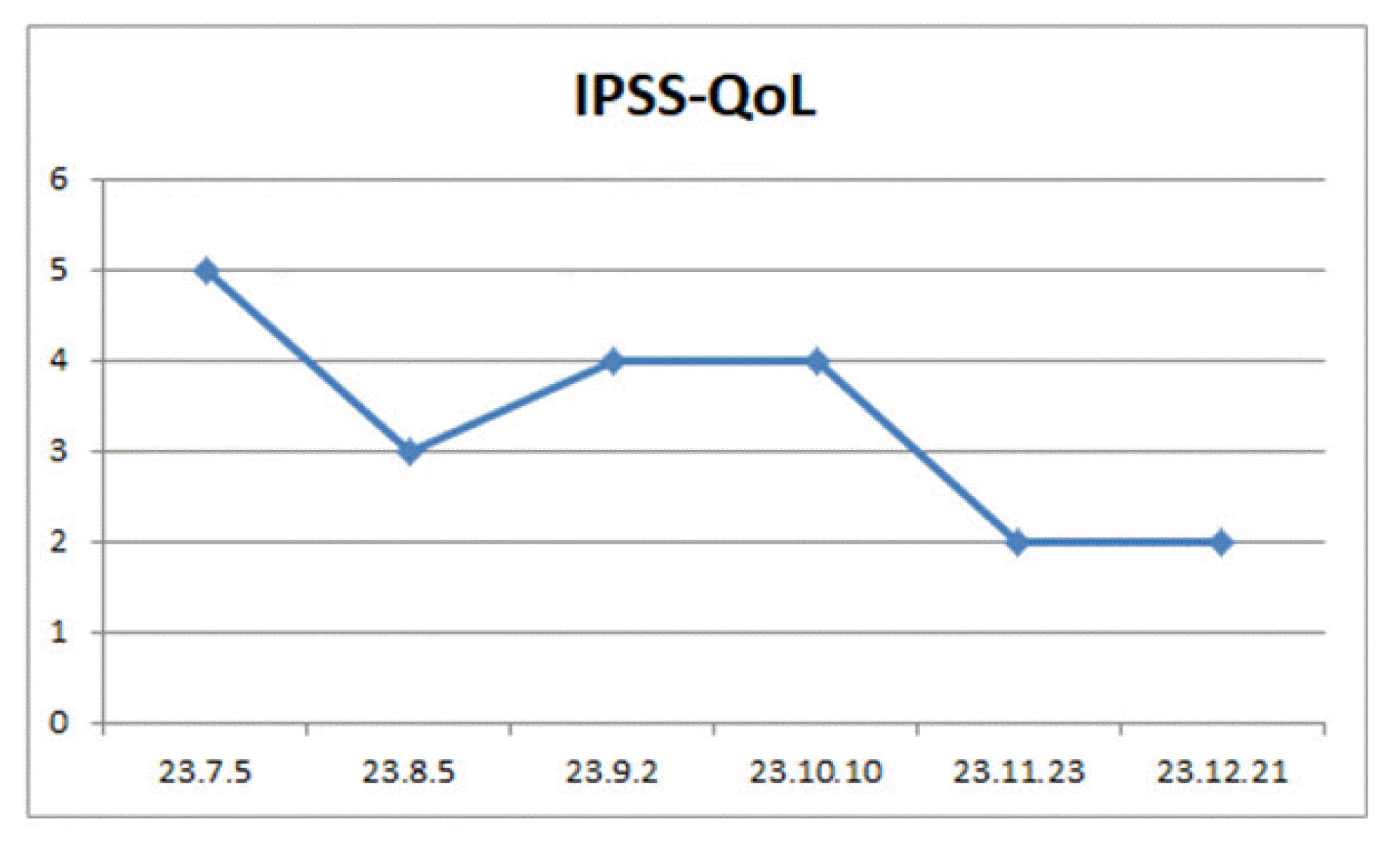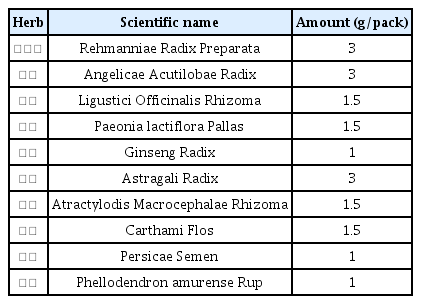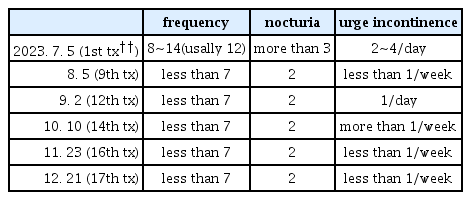References
1. Kang M. J., Jung K. W., Bang S. H., Choi S. H., Park E. H., Yun E. H., et al. 2023;Cancer Statistics in Korea: Incidence, Mortality, Survival, and Prevalence in 2020. Cancer Res Treat 55(2):385–399.
10.4143/crt.2023.447.
2. Giannantoni A., Mearini E., Di Stasi S. M., Mearini L., Bini V., Pizzirusso G., Porena M., et al. 2004;Assessment of bladder and urethral sphincter functionbefore and after radical retropubic prostatectomy. The Journal of Urology 171(4):1563–6.
10.1097/01.ju.0000118957.24390.66.
3. Han J. Y., Choo M. S.. 2011;Drug treatment for lower urinary tract symptoms. J Korean Med Assoc 54(6):637–645.
10.5124/jkma.2011.54.6.637.
4. Amano K., Suzuki K., Ito Y.. 2022;Changes in quality of life and lower urinary tract symptoms over time in cancer patients after a total prostatectomy: systematic review and meta-analysis. Support Care Cancer 30(4):2959–2970.
10.1007/s00520-021-06595-x.
5. Matsubara A., Yasumoto H., Mutaguchi K., Mita K., Teishima J., Seki M., et al. 2005;Impact of radical perineal prostatectomy on urinary continence and quality of life: a longitudinal study of Japanese patients. Int J Urol 12(11):953–8.
10.1111/j.1442-2042.2005.01187.x.
6. Lepor H., Kaci L.. 2004;The impact of open radical retropubic prostatectomy on continence and lower urinary tract symptoms: a prospective assessment using validated self-administered outcome instruments. The Journal of Urology 171(3):1216–1219.
doi.org/10.1097/01.ju.0000113964.68020.a7.
7. Yoon B. I., Hwang T. K., Kim J. C.. 2008;Impact of Laparoscopic Radical Prostatectomy on Urinary Incontinence and Lower Urinary Tract Symptoms. Korean Journal of Urology 49(2):134–138.
10.4111/kju.2008.49.2.134.
8. Choi H. S., Im C. M., Kim S. O., Kim M. K., Deuk Kwon D, Ryu S. B.. 2008;Lower Urinary Tract Symptoms after Radical Retropubic Prostatectomy: Preliminary Study. Korean J Urol 49(8):715–719.
doi.org/10.4111/kju.2008.49.8.715.
9. Jang K. J., Yang J. M., Hwang W. S., Lee B. J.. 2022;Traditional Korean Medicine Treatment for Sequelae After Surgery in Prostate Cancer Patients : Two Case Report. The Journal of Internal Korean Medicine 43(5):795–808.
doi:
https://doi.org/10.22246/jikm.2022.43.5.795.
10. Kim S. Y., Kim S. L., Choi Y. J., Bae J. I., Yoon C. H.. 2012;A Case Report Complications after Radical Retropubic Prostatectomy. Journal of Internal Korean Medicine :351–357.
11. Barry M. J., Fowler F. J., O’Leary M. P., Bruskewitz R. C., Holtgrewe H. L., Mebust W. K., et al. 1992;The American Urological Association Symptom Index for benign prostatic hyperplasia. J Urol 148(5):1549–1557.
10.1016/s0022-5347(17)36966-5.
12. Rhodes P. R., Krogh R. H., Bruskewitz R. C.. 1999;Impact of drug therapy on benign prostatic hyperplasia-specific quality of life. Urology 53(6):1090–8.
10.1016/s0090-4295(99)00041-2.
13. Sagnier P. P., MacFarlane G., Richard F., Botto H., Teillac P., Boyle P.. 1994;Results of an epidemiological survey using a modified American Urological Association symptom index for benign prostatic hyperplasia in France. J Urol 151(5):1266–70.
10.1016/s0022-5347(17)35229-1.
14. Tsukamoto T., Kumamoto Y., Masumori N., Miyake H., Rhodes T., Girman C. J., et al. 1995;Prevalence of prostatism in Japanese men in a community-based study with comparison to a similar American study. J Urol 154(2):391–5.
10.1097/00005392-199508000-00018.
15. Homma Y., Kakizaki H., Yamaguchi O., Yamanishi T., Nishizawa O., Yokoyama O., et al. 2011;Assessment of overactive bladder symptoms: comparison of 3-day bladder diary and the overactive bladder symptoms score. Urology 77(1):60–64.
https://doi.org/10.1016/j.urology.2010.06.044.
17. Castellan P., Ferretti S., Litterio G., Giulio Marchioni, Luigi Schips. 2023;Management of Urinary Incontinence Following Radical Prostatectomy: Challenges and Solutions. Therapeutics and Clinical Risk Management 19:43–56.
10.2147/TCRM.S283305.
18. Chen H., Liu Y., Wu J., Liang F., Liu Z.. 2023;Acupuncture for postprostatectomy incontinence: a systematic review. BMJ Support Palliat Care 13(e1):e10–e19.
10.1136/bmjspcare-2020-002450.
19. Tan M. Y., Mo C. Y., Zhao Q.. 2023;Efficacy and safety of acupuncture in the treatment of urinary incontinence after prostate surgery: protocol for a systematic review and meta-analysis. BMJ Open 13(8):e072516. 10.1136/bmjopen-2023-072516.
20. Chen S., Wang S., Liu S., Wang S., Xuan L., Gao Y.. 2023;Efficacy of electrical pudendal nerve stimulation versus pelvic floor muscle training in treating postradical prostatectomy urinary incontinence: study protocol for a randomised controlled trial. 13(1):e062323. 10.1136/bmjopen-2022-062323.
21. Hoyland K., Vasdev N., Abrof A., Boustead G.. 2014;Post–Radical Prostatectomy Incontinence: Etiology and Prevention. Rev Urol 16(4):181–188.
10.3909/riu0606.
22. Van der Poel H. G., De Blok W., Joshi N., Van Muilekom E.. 2009;Preservation of lateral prostatic fascia is associated with urine continence after robotic-assisted prostatectomy. Eur Urol 55(4):892–900.
10.1016/j.eururo.2009.01.021.
23. Song C., Doo C. K., Hong J. H., Choo M. S., Kim C. S., Ahn H.. 2007;Relationship between the integrity of the pelvic floor muscles and early recovery of continence after radical prostatectomy. J Urol 178(1):208–211.
10.1016/j.juro.2007.03.044.
24. Burzynski B., Jurys T., Knapik M., Burzynski K., Rzymski P., Rajwa P., et al. 2023;Abdominal complex muscle in women with stress urinary incontinence prospective case-control study. Arch Med Sci 19(4):1016–1021.
https://doi.org/10.5114/aoms/135708.
29. Gu Y., Tingting Lv, Jiang C., Jianwei Lv. 2021;Neuromodulation of the Pudendal Nerve Assisted by 3D Printed: A New Method of Neuromodulation for Lower Urinary Tract Dysfunction. Front. Neurosci 15:619672.
https://doi.org/10.3389/fnins.2021.619672.
26. Bava R., Castagna F., Vincenzo Musella, Lupia C., Palma E., Britti E.. 2023;Therapeutic Use of Bee Venom and Potential Applications in Veterinary Medicine. Vet Sci 10(2):119. 10.3390/vetsci10020119.
27. Park H. K., Park H. Z., Cho S. Y., Bum Bae J, Jin Jeong S, Hong S. K., et al. 2009;The Prevalence of Benign Prostatic Hyperplasia in Elderly Men in Korea: A Community-Based Study. Korean Journal of Urology 50(9):843–847.
https://doi.org/10.4111/kju.2009.50.9.843.






